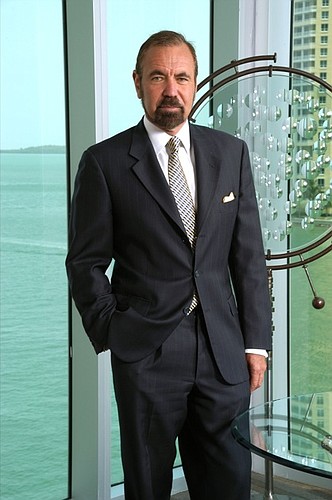- November 24, 2024
-
-
Loading

Loading

REVIEW SUMMARY
Company. The Related Group
Executive. Jorge Perez
Key. Recognizing rapidly changing market trends keeps businesses alive through economic turbulence.
Jorge Perez, the Miami developer who built thousands of condominiums in Florida during the boom, is dreaming about his next project half a world away.
On a recent visit to Fort Myers to promote the fire-sale auction of the Oasis condos he built during the boom, Perez gets most excited talking about his latest project: building homes in India.
With Indian partners, Perez created a company called Astrum Homes, which will provide middle-income housing in India's mid-sized cities with populations between one million and four million inhabitants. “We're very enthusiastic about that,” he says.
It's a striking contrast: Perez, the man responsible for some of the most visible residential towers in South Florida, is sitting in the Oasis on the banks of the Caloosahatchee River in Fort Myers discussing opportunities in India.
In some ways, the founder, chairman and CEO of The Related Group, appears conflicted about Florida. After the real estate collapse, of course, it's easy to understand why.
One moment Perez says it will take years for the state to recover. The next he forecasts Florida's best days lay ahead with the projected deluge of the Boomer generation. On the one hand he says wistfully that he'd focus on Asia if he were starting over as a young man, ignoring questions about his age. On the other, he touts Oasis and other waterfront residential developments as bargains of a lifetime, never to be seen again.
But you can be certain that if there are real estate opportunities, Perez will sniff them out. The Miami planner built 77,000 condos and apartments since he started Related in 1979.
Condo king
Like all builders and developers in Florida, Perez has been forced to change his business in light of the real estate collapse of the last few years.
Perez doesn't shy away from talking about the go-go boom years when lenders would complain bitterly if he excluded them from a deal. Money was so plentiful that Perez says he didn't have to draft elaborate presentations for bankers because they were so eager to finance his projects. At one point during the boom, Perez says he was building 10,000 condos a year.
But asking Perez to talk about condos is a somewhat pointless exercise. We all know what happened and it's time to move on.
If you press him, Perez will acknowledge that there are pockets where new-condo development may make sense, but financing is impossible to obtain. “It's going to be a while before we see any multi-family construction for sale take place,” he says.
What's more, construction costs haven't fallen enough to make it profitable to build condos. In Fort Myers, for example, Perez estimates it costs from $300 to $330 per square foot to build a condo tower today, but prices are now around $150 a square foot.
“How can somebody develop again when you're faced with that?” he asks. Even waterfront condos on upscale Brickell Avenue in Miami are selling for $300 a square foot. “It's a historical aberration,” he grumbles.
Still, Perez hints there may be small projects in unique locations that buyers would finance, not banks. “We are exploring different alternatives,” he says cryptically.
And as sour as Perez is on the condo market, he's unwavering about Florida's future. “Within the U.S., I wouldn't want to be any where other than South Florida,” he says. “I think Florida has a huge future,” he says.
Perez recently traveled with the Miami Dolphins football team to Green Bay, Wisc., and Buffalo, N.Y., markets that will eventually send more residents southward in search of better weather. “When people feel good about themselves, they will continue to invest,” he says. “Now we have more than sun.”
The new Jorge
With the disappearance of new-condo construction, Perez is returning to his roots. “We're looking at affordable-housing rentals and market-rate middle-income housing,” he says.
But with commercial banks on the sidelines, Perez teamed up with Philadelphia-based private-equity firm Lubert-Adler in early 2008 to form a $1 billion buyout fund to purchase distressed assets and loans from other developers, lenders and property owners.
Perez ticks off some of the assets the fund has purchased recently: an office building in Houston, a warehouse in Birmingham, Ala., a housing complex in South Carolina and a shopping center in Phoenix. “At least half our company is on the prowl,” he says.
In Florida, Perez says he's looking for well-located but reasonably priced land in Tampa and elsewhere on which he can build luxury apartments, which he says are in demand now. “We just need to find sites,” he says. “You have to be very careful.”
The challenge has been that lenders haven't been forced to sell distressed land and buildings and have been reluctant to do so because of the associated impact on their capital. Instead, banks have been extending loans to struggling projects. Finding out which assets are in trouble is difficult. “They're still very hidden,” Perez says.
Perez won't weigh in on whether it's better for the banks to dispose of bad assets quickly. “This has to do with the federal government,” he says. The longtime Democratic supporter gives the federal government a “C” for its handling of the downturn.
Because few commercial banks are lending on real estate projects, private equity and hedge funds are filling the void. “Financing has almost disappeared,” Perez says. However, the cost of money from private investors is higher. “Returns are going to be much less than they were,” he says.
For Florida's real estate economy to improve, he says the inventory of existing housing must be absorbed, which could happen more quickly that some expect. “That will happen to a great extent next season,” Perez forecasts. “I don't think we'll see a double dip.”